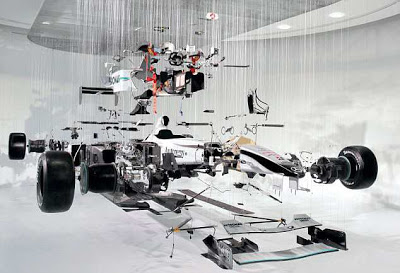 Ever dream of getting behind the wheel of a Formula One or NASCAR race car? Well, believe it or not, a lot of race technology has trickled down to cars that are seen on the streets every day. Undoubtedly, your car already uses some of the same technology developed on the Grand Prix race tracks. (And if you’re interested, this article lists the production cars driven by F1 drivers!)
Ever dream of getting behind the wheel of a Formula One or NASCAR race car? Well, believe it or not, a lot of race technology has trickled down to cars that are seen on the streets every day. Undoubtedly, your car already uses some of the same technology developed on the Grand Prix race tracks. (And if you’re interested, this article lists the production cars driven by F1 drivers!)
Direct-Shift Gearbox
The old days of stick shifts and clutch pedals are long gone. This is because the racers wanted something more precise and reliable which gave birth to the direct-shift gearbox. This technology is an electronically controlled clutch which allows for short shifting times and smoother gear changes. The technology can now be found in Audi and Volkswagen models making them truly high-tech – read more here. What’s even better is that you can select the automatic mode and leave the shifting to the automatic transmission.
Push Button Ignition
When you are racing at Le Mans what is the fastest way to start a car and shift into first gear? You implement a push button starter to the side of the steering wheel, that’s how. This technology developed by Porsche for its race cars was initially meant to shave seconds off the starting process. Other cars require the key to be placed before pushing the button. Another system uses a chip in the key chain that is sensed by the car. This then allows the vehicle to be started by the push of a button when you are seated in the driver’s seat. You can get these fitted to your older car too, but make sure you get a quote (shop around for a good deal!) for a modified car when looking at insurance.
Multi-Link Suspension
Good suspension keeps a race car’s tyres connected to the road. Of course this is also a good thing for production cars, especially 4x4s and SUVs. Independent suspension means that each wheel moves independently from the other wheels, and this makes for a smoother ride. Essentially all production cars carry this race born technology.
Tyres
The rubber and grooves in your car’s tires help with traction in a variety of situations. The grooves, for example, help channel away water and snow to keep the tyre in closer contact with the road surface. In many cases, these advantages were discovered on the race track where traction is of extreme importance.
Brakes Discs
Discs first appeared on race cars then they found their way to production cars. Disc brakes are stronger and more reliable. Initially the discs were made of iron, and this is still the case in most road cars. However, in the search for lighter materials, ceramic discs have found their way into race cars. Today, some higher end production sports cars also have ceramic disc brakes.
Dual Overhead Camshafts
This is a pretty common feature on production cars today. No wonder, they appeared on the race circuits starting back in the early 1900s. Basically, the cams are valves that allow air to flow through the engine. When you have dual cams you can move more air, and fast engines like more air.
Aerodynamic Design
Every second counts on the race track so the Formula One car’s body must be sleek. In the everyday world, wind resistance means lower fuel efficiency and poor handling. These days nearly every production car goes through wind tunnel testing to squeeze out the best fuel efficiency. The School of Engineering at Cranfield University in Bedfordshire regularly runs these tests for the automotive sector.
Rear spoilers are a race car’s trademark that is often seen on today’s road cars. The Porsche 911’s whale tail is perhaps the most famous example.
Materials
Something as simple as lightweight aluminum was originally a race innovation. Today aluminum and other lightweight metals are commonplace on production cars. Lighter weight means faster speeds and also better fuel efficiency.
Safety Features
If you are taking a turn at 200 mph you want to be protected, right? Well in the race car the protection takes the shape of strong roll bars that surround the driver in case of a roll over. Production cars also use this safety feature built into the car’s frame. Finally, the first rearview mirrors were first found on racing vehicles.
Conclusion
Formula One racing technology is exciting, and it allows for drivers to compete at incredible speeds. Thanks to years of competition and research, this technology has steadily been incorporated into production road cars. This means safer, more comfortable and more fuel efficient cars for the masses. You can read more about Formula One cars and the history of the race here.

